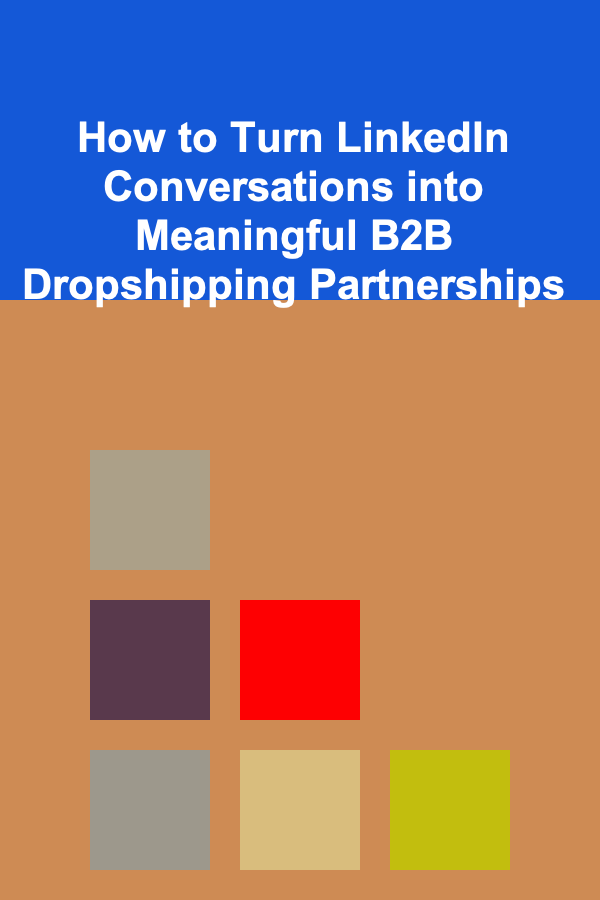
How to Turn LinkedIn Conversations into Meaningful B2B Dropshipping Partnerships
ebook include PDF & Audio bundle (Micro Guide)
$12.99$11.99
Limited Time Offer! Order within the next:

LinkedIn has evolved from a simple networking platform to a robust tool for generating business opportunities, including in the B2B dropshipping space. If you are a dropshipping entrepreneur looking to expand your network and establish valuable partnerships, LinkedIn can be a goldmine. The key lies in converting casual conversations into solid business partnerships that drive growth and profitability.
This actionable guide will walk you through the process of turning LinkedIn conversations into meaningful B2B dropshipping partnerships, breaking down each step with practical insights.
Optimize Your LinkedIn Profile for B2B Dropshipping
Before you initiate conversations with potential partners, ensure that your LinkedIn profile presents you as a professional, trustworthy dropshipping entrepreneur. First impressions matter, and your profile is your digital storefront.
Key Profile Elements to Optimize:
- Profile Photo: Use a clear, professional headshot. This establishes trust and credibility right away.
- Headline: Craft a headline that highlights your expertise in dropshipping. Instead of just stating your job title, focus on your value proposition. For example: "Helping B2B companies scale with high-quality dropshipping solutions."
- About Section: Write a compelling about section that explains who you are, what your business offers, and the types of B2B partnerships you're looking for. Focus on how you can add value to potential partners.
- Experience and Projects: Share detailed information about your dropshipping business experience. Highlight successful collaborations and any notable achievements that demonstrate your capability in the B2B space.
- Skills and Endorsements: List relevant skills such as "B2B Sales," "E-commerce Management," and "Supply Chain Optimization." The more endorsements you gather, the more credibility you gain.
Identify the Right Prospects
Not all LinkedIn conversations will lead to meaningful partnerships. To make the most of your outreach efforts, focus on identifying prospects who align with your business needs and goals. The goal is to find companies that can either be suppliers or distributors and who share your vision for growth.
Steps to Identify the Right Prospects:
- Define Your Ideal Partner: Consider factors such as company size, industry, business model, and geographic location. Are they already engaged in dropshipping, or could they benefit from integrating this model into their business?
- Search and Filter: Use LinkedIn's advanced search filters to narrow down prospects. Focus on specific industries, job titles (e.g., Business Development Manager, E-commerce Director), or companies that fit your ideal partnership profile.
- Research the Prospect: Before reaching out, research your target prospect's LinkedIn activity, company details, and their recent posts. This will help you understand their needs, challenges, and whether they align with your offerings.
Craft Personalized Connection Requests
The first step in engaging with a potential B2B dropshipping partner is sending a connection request. However, the key here is personalization. A generic message will most likely be ignored, whereas a personalized, value-driven approach has a much higher chance of success.
Tips for Writing a Compelling Connection Request:
- Introduce Yourself: Keep your introduction brief but engaging. Mention your role, company, and your reason for reaching out.
- Mention Common Ground: If you have mutual connections, mention them. If you share a group, comment on their post, or attended a similar event, bring it up. This establishes a reason for connecting.
- Value Proposition: Briefly explain why connecting could be beneficial for both parties. Focus on how a potential partnership could help them grow or solve a challenge they may be facing.
Example of a good connection request:
"Hi [Name], I came across your profile and noticed that you are leading [Company Name] in the [Industry]. I specialize in helping companies like yours expand their e-commerce operations through effective dropshipping models. I'd love to connect and explore potential collaboration opportunities that could help streamline your supply chain. Looking forward to connecting!"
Nurture Relationships Through Meaningful Conversations
Once your connection request is accepted, it's time to engage in meaningful conversations. This phase is about building trust and positioning yourself as a reliable partner, not rushing straight into business talks.
Tips for Meaningful Conversations:
- Start with Gratitude: Thank them for accepting your connection request. This sets a positive tone for the conversation.
- Avoid Pitching Immediately: Start by getting to know the person and their business. Ask open-ended questions about their goals, challenges, and current operations.
- Provide Value: Share relevant insights or resources that can help them in their business. This could be an article you wrote, an industry report, or a helpful tool you've found. Establish yourself as a thought leader in the dropshipping space.
- Listen Actively: Pay close attention to their responses. This will give you insights into their pain points, which you can use to craft a tailored proposal later.
Example of how to transition the conversation:
"I understand that [specific challenge] can be tough. In my experience, many businesses in [industry] have struggled with [problem], but they've seen tremendous improvement by adopting a more streamlined dropshipping model. I'd love to share how we've helped similar companies overcome this challenge. Would you be open to a quick chat?"
Offer Solutions and Build the Case for Partnership
Once you've built rapport and established trust through your conversations, it's time to position your business as the solution to their pain points. This is where you can present your dropshipping model and how it could benefit their company.
How to Position Your Dropshipping Business as a Solution:
- Identify Pain Points: Refer to the challenges they mentioned earlier and explain how dropshipping can help address these specific problems (e.g., inventory management, shipping costs, etc.).
- Tailor Your Offer: Customize your dropshipping offer to fit their needs. If they are an e-commerce business, emphasize how dropshipping can reduce upfront costs, allow for product diversification, and scale their offerings. If they are a supplier, explain how dropshipping can expand their reach to new markets without the burden of managing fulfillment.
- Share Success Stories: Provide case studies or examples of businesses similar to theirs that have benefited from your dropshipping services. This builds credibility and demonstrates the tangible impact of your solution.
- Discuss Terms and Expectations: Begin outlining the basic structure of the partnership, including pricing, fulfillment processes, and any other important details. Be transparent and clear about what both parties can expect.
Move Towards a Formal Proposal
After discussing the potential partnership and gauging interest, it's time to formalize the agreement. Moving forward, the goal is to create a proposal that aligns with both parties' objectives.
Key Elements of a B2B Dropshipping Proposal:
- Clear Objectives: State the goals of the partnership, such as increasing sales, expanding product offerings, or reducing overhead costs.
- Pricing and Payment Terms: Be specific about pricing models (wholesale rates, minimum order quantities) and payment structures (e.g., net 30, PayPal, bank transfers).
- Logistics and Fulfillment: Detail how orders will be processed, shipping timelines, and any expectations regarding packaging and branding.
- Performance Metrics: Set measurable goals and KPIs (key performance indicators) that both parties can track to ensure the partnership is successful.
Example of Proposal Content:
"Based on our discussions, I believe that our dropshipping partnership could help you expand your product offerings without the risk of overstocking. We'd be happy to provide you with a full catalog of our products, with a starting discount of 10% off retail prices. Our fulfillment team can guarantee 2-day processing and 5-7 day shipping for all orders."
Follow Up and Stay Engaged
Even after sending the proposal, the process isn't over. Successful B2B partnerships require ongoing communication and follow-ups.
Tips for Effective Follow-ups:
- Be Polite and Professional: Avoid being overly pushy. If they don't respond right away, follow up with a polite message asking if they have any questions or need further clarification.
- Stay Engaged: Continue to build the relationship by sharing relevant content, industry news, or updates about your business. This keeps you top of mind and reinforces the value you can provide.
- Seek Feedback: After closing the deal, check in regularly to see how things are progressing. Ask for feedback and make adjustments if necessary to ensure both parties are satisfied.
Conclusion
Turning LinkedIn conversations into meaningful B2B dropshipping partnerships requires a strategic, relationship-focused approach. By optimizing your profile, identifying the right prospects, nurturing connections, offering tailored solutions, and maintaining ongoing communication, you can build successful, long-lasting business relationships that drive growth for both parties.
In the world of dropshipping, partnerships are key to scaling and succeeding. Approach LinkedIn not just as a platform for networking but as a valuable tool for creating mutually beneficial business relationships. By following the actionable steps outlined above, you'll be well on your way to transforming LinkedIn conversations into prosperous B2B dropshipping partnerships.
Reading More From Our Other Websites
- [Personal Finance Management 101] How to Make a Plan for Paying Off Student Loans
- [Personal Care Tips 101] How to Apply Shaving Cream for Shaving Your Face: Men's Tips
- [Horseback Riding Tip 101] Best Ways to Introduce a Young Foal to Groundwork Without Stress
- [Home Budget Decorating 101] How to Craft DIY Furniture: Building Beautiful Pieces on a Budget
- [Home Storage Solution 101] How to Maximize Kitchen Storage with Creative Solutions
- [Personal Care Tips 101] How to Identify Your Personal Care "Love Language" and Prioritize It
- [Home Storage Solution 101] How to Maximize Storage for Kids' Books Without Compromising Style
- [Personal Care Tips 101] How to Make Aftershave a Part of Your Daily Grooming Routine
- [Metal Stamping Tip 101] Top 5 Must-Have Features in Modern Metal Stamping Machines for High-Precision Production
- [Soap Making Tip 101] Essential Soap-Making Tools Every Beginner Should Own

How to Create a Tenant Handbook for Clear Communication
Read More
How to Manage Seasonal Family Activities with Effective Planning
Read More
Sustainability at the Core: Practical Approaches for Environmental Consultants
Read More
How to Observe Birds in Urban Environments
Read More
How to Get Involved in Climate Storytelling
Read More
10 Tips for a Paper-Free Daily To-Do List System
Read MoreOther Products

How to Create a Tenant Handbook for Clear Communication
Read More
How to Manage Seasonal Family Activities with Effective Planning
Read More
Sustainability at the Core: Practical Approaches for Environmental Consultants
Read More
How to Observe Birds in Urban Environments
Read More
How to Get Involved in Climate Storytelling
Read More